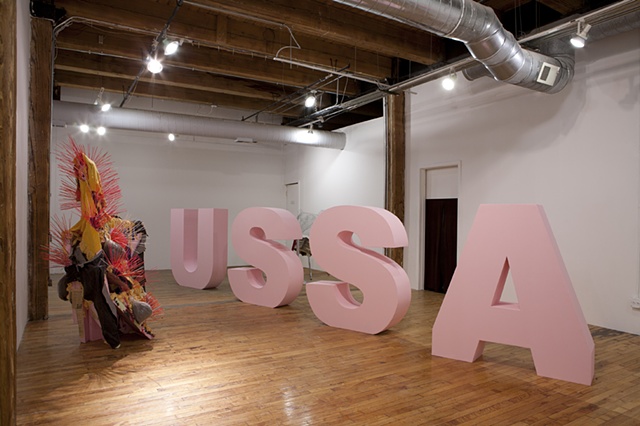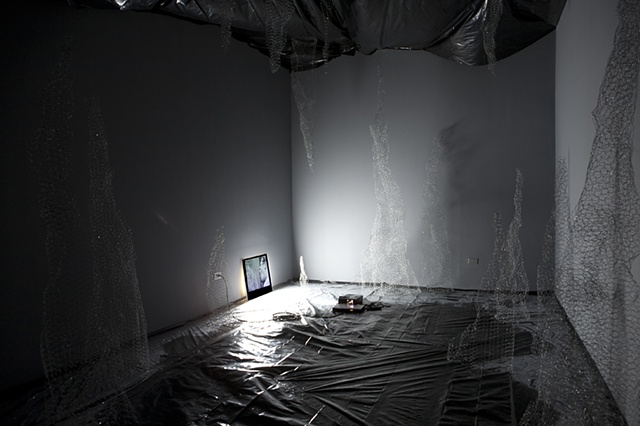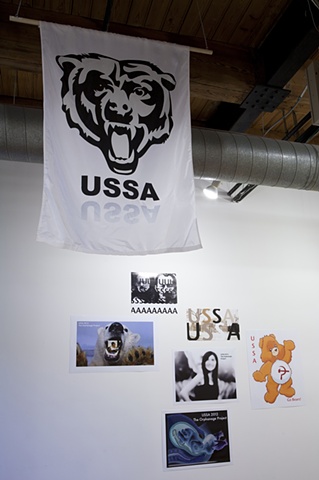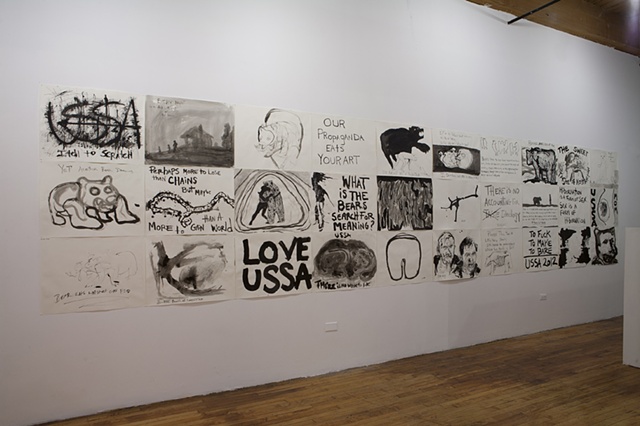Chicago-based multimedia artist and writer Zach Cahill’s The Orphanage Project is easily the most conceptually difficult gallery show I’ve attempted to write about in criticism. A sprawling conceit about the parental nation-state, the exhibition ostensibly spun out from Cahill’s purported attempt to create an orphanage on the South Side–conceived partially as a relational art project. In a Bad at Sports podcast previous to the show’s opening at threewalls this past fall, Cahill expounded on this project to his seemingly confounded interviewer, fellow artist Philip von Zweck, describing it as both a “site for orphans” and “living painting or sculpture,” which was enough for people to come into the gallery show enraged. (Cahill refused to elaborate on any truth status regarding the actual orphanage project in my own interview with him.)
The Orphanage Project’s first incarnation at threewalls in October was a baffling and exhilarating collection of pseudo-propaganda art, sculptural flotsam and jetsam, and the Soviet bear iconography–the use of the USSA epithet in several works clearly drew parallels between authoritarian, imperialistic power here and in the former Soviet Union. Some rough drawings Cahill attributed to his orphans. The back room of three walls was turned into a darkened cave with stalagmites.
All of the work gestures at a murky project with no clear outlines and loaded with political and social suggestions more than answers; what exactly is the role of the orphanage here? If it is merely symbolic, what structures is the metaphor standing in for? Or, as it seemed after awhile, not standing in for?
But what interested me even more than the concept of the orphanage project was the way that its form (a diffuse, sweeping collection of symbols with a mysterious, questionable truth claim at its core) took up a form of relational aesthetics (usually our easiest contemporary scapegoat for lazy art) and made it both actually substantive and potentially political.
Attempting to encapsulate the show, as I wrote for my New City review, quickly became extremely difficult because the project’s scope as a whole is so big; the exhibition essay by Joan Copjec cited everyone from Bourdieu and Lacan to Newt Gingrich (who had his own reveries about orphanages), as well as political theoretical analysis about late capitalism and the relationship between museums and orphanages.
To begin to come to terms with the work, the spectator simply has to do research on her own: reading Cahill’s writing, listening to the podcast, teasing out Cahill’s symbols and political arguments. That labor is part of the project, which also takes up notions of labor thematically, and so the relationality of the work becomes integral to the meaning of the show. (Even now, after probably a dozen hours of research about the various threads in the show, I feel I’m missing some major piece of information that would allow me to come to a complete understanding of what Cahill is up to–which I believe is completely intentional).
The show also critiques the political implications of the gallery show itself. Explorations of art’s use-value, relational aesthetics, 1990s neo-conservatism, various branches of neo-Marxism, Foucault’s arguments about governmentality, become part of the art exhibition model itself here as a combination of propaganda and sculptural fragments as material traces of ideology. The orphanage itself, as suggested on the threewalls website, is merely a red herring.
I couldn’t stop thinking about the show after reviewing it, in part because of the investment (that loaded term) I had made in the work through my own research, so when I learned from Cahill that The Orphanage Project would be remounted next month at Antioch College (another socially and politically loaded site for housing young people), I knew I had to interview him about the show.
Monica Westin: Part of what makes this project so compelling to me is there is seemingly no way to come to a final interpretation. I found I had to do a lot of research before I felt comfortable even writing about the show. How do you see all its layers working together?
Zach Cahill: It’s really two shows at once. If you never make it to Chicago, you have one piece formed through the writing and interviews, like the Bad at Sports podcast, versus what you would experience physically and visually at the gallery show. This doubling is a chance to open up the project.
MW: What about the critical work of the figure of the orphan? I kept thinking about the gallery space as a kind of orphanage, where both the works of art are orphans ripped from their studios, but also the people there.
ZH: The figure of the orphan articulates our capacity to be filled in by pop culture, consumer culture… it’s a blank slate and also its own mode of interpellation.
MW: I spent a lot of time trying to figure out the political position of the show. Copjec’s essay pulled out threads of neoconservativism’s hypermodern, various conceptualizations of capitalism, and then of course there’s the reference to the Soviet Union. What was your sense of the political scene going into the show?
ZH: I was thinking a lot about human agency and the capacity to change what’s there. When I hear people railing against the way things are, I also imagine that in a sense we are choosing this world instead of another world, with everything we do. We are not totally agentless in the world we inhabit. Especially when driving and looking at the American landscapes I keep thinking, “why do we live this way?” We choose it collectively… But just because I feel these massive contradictions doesn’t mean I don’t have convictions.
MW: So did you build the orphanage? Does it matter?
ZH: It’s important people think that–what the implications of what that means. First of all it puts you in the position to make certain judgments–perhaps to get really upset.
MW: One way that the orphanage theme plays out politically for me is in thinking about maternal and paternal visions of the nation-state, particularly the cultural myth of the right wing being more “tough love” and paternalistic and so forth.
ZH: Yes. I was thinking a lot about the “Nanny State” during the cold war. The Russian bear figures in the work in that way…. I’m also sincerely in awe of the model of Sarah Palin as a mama grizzly, which is a really strange contrast as she wants to gut social programs. As far as changes to these familial metaphors of the state, what drives a lot of my work is studying a sort of metempsychosis of ideology, how it takes on new forms at different times in political history. This is also tied up in ideology and the notion of instrumentalism in human behavior that goes back to the parent-child relationship; we need each other to do things… There’s an indebtedness to all our lives, from the debt we can’t ever pay to our parents, onward. It runs from individual to group, orphanage, country.
MW: Are you still working on conceptualizing the relationship between The Orphanage Project and the world? It seems like it could spin out indefinitely.
ZH: The show is still bubbling up inside me. I’m not done yet. I’m getting more interested in a state in which we become unmoored, wayward, being allowed to roam.
The Orphanage Project will open at the Herndon Gallery at Antioch College March 2nd.







